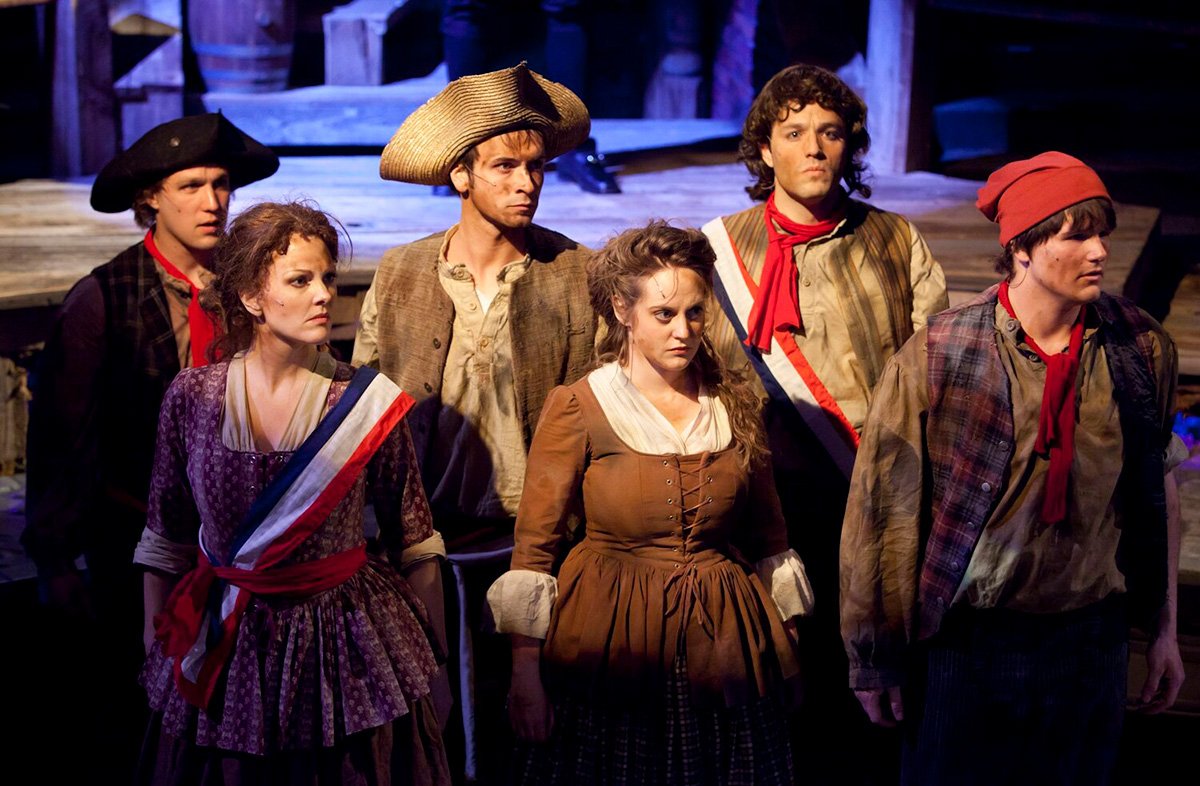
“It was the best of times; it was the worst of times.”
These are perhaps the most recognized opening lines in the history of English literature. It was certainly the most memorable line of any book I ever read during my time in school. I remember reading A Tale of Two Cities when I was a sophomore at North Penn High School just outside of Philadelphia, PA. It made such an impression that I often referred to the story as being my favorite, so you can imagine my delight when this book, that so struck me in school, was brought to the stage — and in a production that I would direct, no less. In the years that have followed, A Tale of Two Cities, the Musical by Jill Santoriello has continued to be the pinnacle of my directorial achievements and I look forward to a day soon when I may direct it once again.
“It was the age of wisdom; it was the age of foolishness.”
The opening passage of A Tale of Two Cities outlines a theme of duality for the entire book. To many, living in England in the late 1700’s, “it was the spring of hope.” To many, living in France during the French Revolution, “it was the winter of despair.” This message of duality at the beginning of the book is clear and indelible.
However, during my time at the helm of Hale Centre Theatre’s production of A Tale of Two Cities, I discovered the ultimate message of this show, even with its tragic end, a message of redemption, resurrection, and a second chance at life.
This message is the key to my love of this story and my love for Charles Dickens. You see, in addition to directing the musical, A Tale of Two Cities, I have also been telling another classic Charles Dickens story of redemption. I have been fortunate to be a part of Hale Centre Theatre’s production of A Christmas Carol as an actor and director for the last 18 consecutive years. The theme of redemption and a second chance at life has defined my own life as an actor, director, and a man.
In A Christmas Carol we experience the redemption and second chance at life for Ebenezer Scrooge. In A Tale of Two Cities, more than one character has an opportunity at a second chance in life; Dickens refers to it as being “recalled to life” during this story. Dr. Alexandre Manette is the first at the beginning of the story. After being unjustly imprisoned for 17 years, he is recalled to life for threatening to expose the crimes of corrupt aristocrats. He is ultimately found and saved through the love of his daughter, Lucie.
Charles Darnay, the husband of Lucie Manette, is twice recalled to life by Sydney Carton. The first time is less obvious as Sydney uses his wits as an attorney to set Charles free during his trial for treason in England, but the second time is much more purposeful, obvious and is tied directly to Sydney Carton’s own resurrection and redemption. As Charles Darnay waits in a cell to fall victim to “Madame Guillotine,” Sydney takes his place leveraging his wits against one of the many scoundrels he has associated himself with in his life. This time, his deception puts himself in harm’s way and delivers his own opportunity for redemption. He will die at the hands of Madame Guillotine and once again give Charles Darnay another chance at life with his wife and daughter, both of whom Sydney has grown to love. Sydney would make any sacrifice for these women’s happiness, even if it means an end to his own life. In this moment, he discovers his own spiritual awakening; in his death, he will find life once again.
I have been fortunate enough to be a part of more than 150 productions in my life, but I have never staged a song as beautiful and touching as “Let Her Be A Child.” Charles Darnay singing to the thought of never seeing his daughter again as he awaits his imminent death, while at the same time seeing Sydney Carton come to the decision that he will sacrifice his own life so that Charles, Lucie, and their daughter can be together. It is beautiful storytelling on the part of Jill Santoriello and I believe it is the absolute best male duet in all of musical theatre.
But the moment that I consider the most unforgettable in my directing career happens as Sydney Carton ascends the stairs to the last moment of his life. He reprises the song “I Can’t Recall,” and as he walks up the stairs to our catwalk with the light of God shining down on him from above, he turns and delivers what is perhaps the most recognized closing line of any novel in English literature:
“It is a far, far better thing that I do, than I have ever done; it is a far, far better rest that I go to than I have ever known.”
The cast that performed in our production of A Tale of Two Cities for Hale Centre Theatre was the absolute best of the best. Performers who typically played leading roles gladly played in the ensemble just to be a part of what they knew was going to be a special experience. To this day, cast members proclaim that A Tale of Two Cities, the Musical was the best show they have been a part of and audience members frequently request the show to be performed again.
The source material, the history, the music, the storytelling, the laughs, the tears, the message of redemption — these are all reasons A Tale of Two Cities should be considered a cornerstone of any theatrical season. It is also an excellent production to consider for schools because of its historical significance and roots in the literary canon.
A Tale of Two Cities is a far, far better show than I have ever had the privilege to direct.
…
To purchase your copy of A Tale of Two Cities, the Musical, click here. For performance rights, click here.
(photo: Doug Carter)

Women and Show Biz: A Conversation with Playwright Peter Quilter

A Pan of Buttermilk Biscuits: Purlie Victorious and Sustenance

